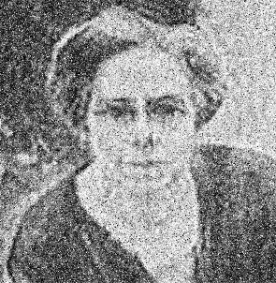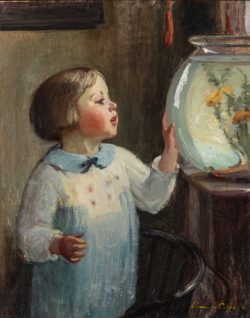Elanor Colburn, detail from a portrait painted by Ruth Peabody reproduced in Memorial Exhibition the Paintings of Elanor Colburn, Fine Arts Society of San Diego, 1939.

Elanor Colburn 1866–1939
Born Eleanor Ruth Gump in Dayton, Ohio, Elanor Colburn moved with her family to Chicago as a child. She studied at the Art Institute of Chicago and later taught there. She is said to have also studied with William Merritt Chase and Frank Duveneck. Beginning in 1899 she exhibited genre pictures, portraits, and landscape paintings in the Art Institute’s annual exhibitions, and she belonged to and showed with several Chicago artists’ organizations, including the Society of Western Artists. Colburn worked in watercolor as well as in oils and was noted for images of mothers and children and for marines. In 1909, a marine by Colburn was awarded a purchase prize from the Municipal Art League and joined its collection, one designed to bring accessible works by local artists to a wide public in the city. Of her painting of a little girl exhibited in the Art Institute’s 1912 American art annual, reviewer James William Pattison observed that the artist “has set herself a difficult problem and done it well.”i Her paintings on the Four Elements, each symbolized by a pretty young woman, were reproduced in the “premium calendar” issued for 1913 by the Chicago-based meatpacking company Swift, as advertised in the Christmas 1912 issue of The American Magazine.
The artist married Charles Harry Eaton, a self-taught New York landscape painter, in 1891; their daughter, Ruth Eaton (later Peabody) was born the following year and eventually followed her mother into an artistic career. The Eatons divorced around 1897, and in 1898 Eleanor married Joseph Elliott Colburn, an ophthalmologist and self-taught landscape painter interested in color theory. Eleanor had been specializing in marine paintings since about 1909. Her “passion for the ocean,” according to her friend and fellow artist Lucie Hartrath, as well as a wish to be free of domestic responsibility in order to focus on her art, according to her husband, prompted her to separate from him, in 1912; they were divorced by 1915.ii
Eleanor Colburn had moved from Highland Park to a Chicago address around 1909. She may also have lived for a time in New Hampshire, and in the early 1920s she was part of a community of artists who worked in Ogunquit, Maine, where she exhibited with the Village Studio Guild. Colburn had also visited Southern California, and in 1924 she and Ruth relocated there permanently. In the lively artists’ community of Laguna Beach, they opened a studio for teaching as well as painting; however, census records and telephone directories list Eleanor’s addresses as Orange (from 1926 to 1934) and subsequently Anaheim.
After a several years of limited work as she recovered from illness, in 1927 Colburn shifted from a rather sedate academic impressionism to a modernist mode influenced by Post-impressionism and the theory of Dynamic Symmetry, a new proportioning system and natural design methodology that found favor with many Southern California artists. Perhaps to signal this artistic shift, that year she also changed the spelling of her first name to Elanor. She continued to focus on the figure, usually set within the landscape, and she reinterpreted her familiar mother-and-child theme with Navajo, African American, and other less conventional models. Colburn became an active member of and exhibitor with several regional artists’ organizations, winning a number of prizes, and she served as director of the Laguna Beach Art Association from 1926 to 1929. In 1939, following her death, Ruth Peabody organized a memorial exhibition of Colburn’s work in the gallery of the Fine Arts Society of San Diego.
Wendy Greenhouse, PhD
i James William Pattison, “The Annual Exhibition of American Art,” Fine Arts Journal 26 (Jan. 1912): 32.
ii “Art and Ocean Lure Wife,” New York Times, Jan. 11, 1912.
